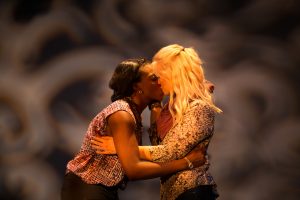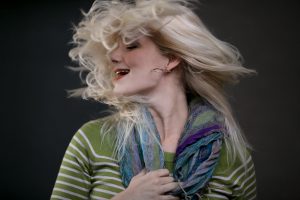Lack of References Scuttles Well-Intentioned ‘Bright Half Life’
Tanya Barfield’s Bright Half Life, the current mount at Diversionary Theatre, sports a title that pretty well illuminates the idea behind the story. The play tracks a lesbian relationship over 40 years, with a cavalcade of landmarks big and small (kissing, lovemaking, marrying, fighting, divorcing, sky-diving, kite-flying, elevator-riding, bed-buying) under scrutiny. In the abstract, one life here is the sum of its two parts – and if “bright” equates with “seasoned,” the name is rather apt.
For all their quirky differences, the duo is also remarkably similar in gaits and hand gestures, lending another layer of simpatico to the mix. Race gets into the act too (crazy Erica’s white, referential Vicky’s black), making this relationship all the more interestingly improbable and thus perhaps all the more a matter of destiny.
Barfield constructs her action out of time, with Erica’s lame marriage proposal immediately melding into a sky-dive years down the road, a future squabble yielding a past roll in the hay and so on. Nothing wrong in the least with the unorthodoxy, as it shakes up the players in time and space. Where things go awry is in the acting, as the personnel are quite a ways off from complementing Barfield’s stylized approaches with some of their own. Add the threadbare exposition, and Bright Half Life isn’t a play so much as a sketch, albeit one steeped in a pretty good idea.

Vicky (Bri Giger, left) and Erica (Rin Ehlers Sheldon) don’t exactly look like they’re headed for divorce court anytime soon. Photos by Simpatika.com.
The show does boast a decent fundamental chemistry between the girls. Director Lydia Fort exploits it, or at least she’s seen fit not to modify the actors’ correct tendencies toward physical sameness – the wide-open palms, the angled cocks of the head, even the bends at the knees during a sky-dive seem in sync, establishing a mirror image between two lovers who, even as they flaunt their many differences, are more alike than even they realize.
From there, though, a lot gets lost in translation. While the temporal zigzags are enlivening, they’re also left as devices unto themselves. Those wide-open palms, angled cocks of the head and bends at the knees never fuel Barfield’s attempts at stylization as she darts back and forth in time with her vignettes. Parallel affectations meet with a purposely jambled series of vignettes – it’s like looking at a kaleidoscope whose compartments are all the same color.
Beyond that, Rin Ehlers Sheldon’s Erica and Bri Giger’s Vicky aren’t too bad as the star-crossed couple. Just as they’ve cultivated the roles’ physical parallels, so too do their characters exercise a certain restraint in blaming the mainstream world for their difficulties. Barfield does this on purpose, I think, opting to focus the audience on the personal responsibility element in each woman’s search for contentment. The world may bend these characters over, but they still have to react – the playwright carries this message persistently, and the girls reflect it well.

Erica’s hair is as crazy as she is.
Human existence is a breathtakingly brief proposition, and this play knows that. It scrunches four decades into 70 minutes, using the illusion of time to reflect the crush of experiences involved in the truly realized life. But Fort and Pulitzer Prize finalist Barfield approach that richness from two different strata, leaving us to wonder which is the more credible. Life, especially married life, is either a patiently enduring proposition or a set of rules broken way more often than not. It isn’t both.
This review is based on the matinee performance of Nov. 7. Bright Half Life runs through Nov. 29 at Diversionary Theatre, 4545 Park Blvd. in University Heights. $22-$40. (619) 220-0097, diversionary.org.


